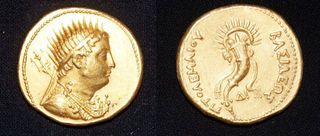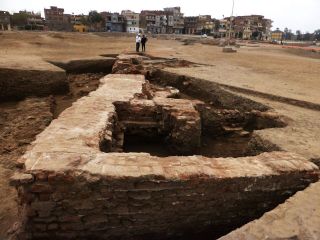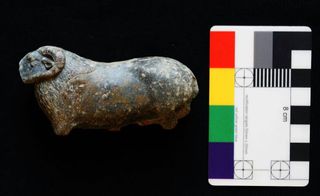Intriguing Gold Coin and Other Treasures Uncovered in Egypt

Archaeologists in Egypt have unearthed the remains of a huge, red, brick building — likely the remnants of a Roman bath — as well as a mountain of treasures, including a statue of a ram and a gold coin featuring King Ptolemy III, according to the Egyptian Ministry of Antiquities.
The building itself is huge — for Roman times, anyway — measuring about 52 feet (16 meters) long, or nearly as long as a bowling lane. The structure likely dates to the Greco-Roman era, Ayman Ashmawy, head of ancient Egyptian antiquities, said in a statement released May 23.
The artifacts the archaeological team uncovered at the site of San El-Hagar, in Tanis, include pottery vessels, terra-cotta statues, bronze tools, a stone fragment engraved with hieroglyphs and a small ram statue. [In Photos: Ancient Egyptian Tombs Decorated with Creatures]
The gold coin, in particular, caught the archaeologists' attention. It features King Ptolemy III and was created during the 221 B.C. to 205 B.C. reign of King Ptolemy IV in memory of his father, according to Saeed Al-Asal, head of the archaeological mission.

One side of the 1-ounce (28 grams) coin depicts the face of King Ptolemy III, who is shown wearing a dazzling crown. The other side of the coin has a symbol of prosperity that looks like a cornucopia, which is surrounded by the name of the king.
The archaeologists plan to continue excavation work at the site in the coming field seasons so they can learn more about the building and how ancient people may have used it.

Original article on Live Science.
Sign up for the Live Science daily newsletter now
Get the world’s most fascinating discoveries delivered straight to your inbox.

Laura is the archaeology and Life's Little Mysteries editor at Live Science. She also reports on general science, including paleontology. Her work has appeared in The New York Times, Scholastic, Popular Science and Spectrum, a site on autism research. She has won multiple awards from the Society of Professional Journalists and the Washington Newspaper Publishers Association for her reporting at a weekly newspaper near Seattle. Laura holds a bachelor's degree in English literature and psychology from Washington University in St. Louis and a master's degree in science writing from NYU.
Most Popular

